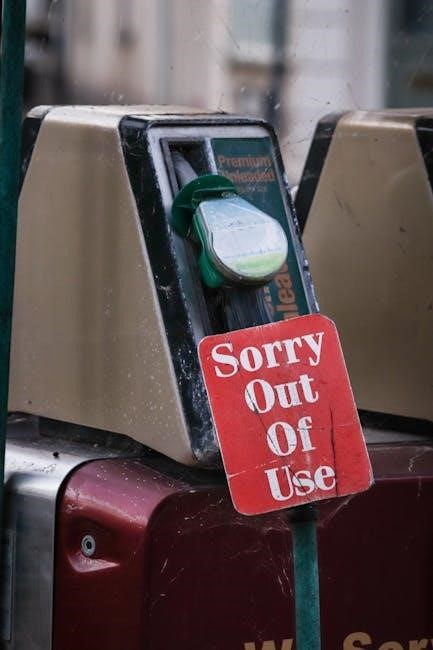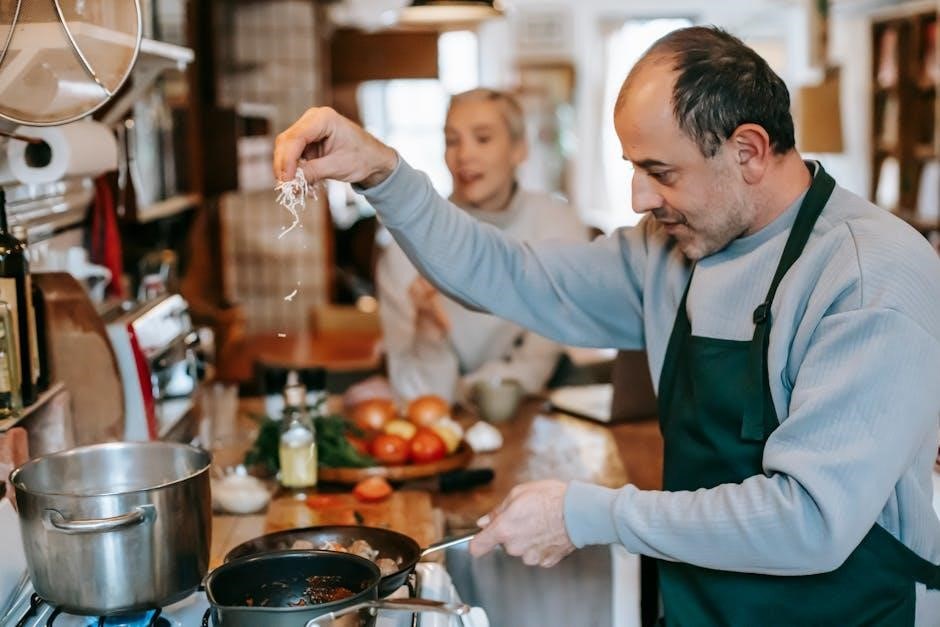Gas Stoichiometry Problems with Answers PDF: An Overview
Gas stoichiometry involves using balanced chemical equations and the ideal gas law to solve for unknown gas quantities. A PDF resource offering solved problems provides valuable practice. These problems often encompass volume-volume‚ mass-volume‚ and limiting reactant scenarios‚ aiding comprehension.
Key Concepts in Gas Stoichiometry
Understanding gas stoichiometry requires a grasp of core principles. These include the ideal gas law‚ molar volume at STP‚ and mole ratios derived from balanced chemical equations. Mastering these concepts is crucial for successfully solving gas-related stoichiometry problems.
Ideal Gas Law and its Application
The ideal gas law‚ PV = nRT‚ is fundamental to gas stoichiometry‚ relating pressure (P)‚ volume (V)‚ moles (n)‚ ideal gas constant (R)‚ and temperature (T). Its application allows us to determine unknown variables when others are known‚ assuming ideal gas behavior. Remember that the gas constant‚ R‚ has different values depending on the units used for pressure and volume; the most common is 0.0821 L atm / (mol K).
To apply the ideal gas law effectively‚ ensure consistent units. Convert temperature to Kelvin (K = °C + 273.15) and pressure to atmospheres if necessary. The ideal gas law helps convert between moles and volume of gases‚ a crucial step in many stoichiometry calculations.
Real gases deviate from ideal behavior at high pressures and low temperatures. However‚ under standard conditions‚ the ideal gas law provides a good approximation for gas stoichiometry problems. Mastering its application is essential for success.
Molar Volume at STP (Standard Temperature and Pressure)
At Standard Temperature and Pressure (STP)‚ defined as 0°C (273.15 K) and 1 atmosphere (atm)‚ one mole of any ideal gas occupies approximately 22.4 liters. This molar volume at STP provides a convenient conversion factor for gas stoichiometry problems. Using this value simplifies calculations when dealing with gases under these specific conditions.
Knowing the molar volume at STP allows for direct conversion between moles of a gas and its volume. If you know the number of moles of a gas at STP‚ multiplying by 22.4 L/mol gives the volume. Conversely‚ dividing the volume of a gas at STP by 22.4 L/mol gives the number of moles.
This concept is particularly useful for quickly estimating gas volumes in chemical reactions. However‚ remember that this value is only accurate at STP. Deviations from these conditions require using the ideal gas law for correct calculations.
Mole Ratios from Balanced Chemical Equations
Balanced chemical equations are the cornerstone of stoichiometry‚ providing essential mole ratios between reactants and products. These ratios allow us to predict the amount of product formed from a given amount of reactant‚ or vice versa. In gas stoichiometry‚ understanding mole ratios is crucial for calculating volumes of gases involved in reactions.
The coefficients in a balanced equation represent the relative number of moles of each substance. For example‚ in the reaction N2(g) + 3H2(g) → 2NH3(g)‚ one mole of nitrogen reacts with three moles of hydrogen to produce two moles of ammonia.
These mole ratios act as conversion factors. Knowing the moles of one substance‚ you can use the ratio to find the moles of another. This is vital when converting from a given volume of gas to the moles of another gas in the reaction. Always ensure the equation is correctly balanced before using mole ratios.

Types of Gas Stoichiometry Problems
Gas stoichiometry problems vary‚ including volume-volume relationships‚ mass-volume conversions‚ and identifying limiting reactants when gases are involved. Each type requires a tailored approach using stoichiometry principles and gas laws for accurate solutions.
Volume-Volume Stoichiometry
Volume-volume stoichiometry problems focus on reactions where all reactants and products are gases. These problems simplify calculations since‚ at the same temperature and pressure‚ the mole ratio is equivalent to the volume ratio. This allows for direct conversion between reactant and product volumes using the balanced chemical equation’s stoichiometric coefficients.
Solving these problems often involves applying Avogadro’s law‚ which states that equal volumes of all gases‚ at the same temperature and pressure‚ contain the same number of molecules. Therefore‚ if the reaction conditions remain constant‚ the volume ratio derived from the balanced equation can be directly used to determine unknown volumes.
Consider a reaction where nitrogen gas reacts with hydrogen gas to produce ammonia gas. If you know the volume of nitrogen gas reacting‚ you can directly calculate the volume of ammonia produced using the stoichiometric ratio from the balanced equation‚ assuming constant temperature and pressure. This direct relationship makes volume-volume stoichiometry a straightforward application of gas laws.
Mass-Volume Stoichiometry
Mass-volume stoichiometry involves calculations where the amount of one substance is given in mass (grams)‚ while the amount of another substance (usually a gas) is to be determined in volume (liters). These problems require converting mass to moles using molar mass and then applying the ideal gas law to find the volume‚ or vice versa.
The key to solving these problems is to first convert the given mass into moles using the substance’s molar mass; Once the number of moles is known‚ the balanced chemical equation is used to determine the corresponding number of moles of the gas involved. Finally‚ the ideal gas law (PV=nRT) is applied to calculate the volume of the gas at the specified conditions of pressure and temperature.
For example‚ consider a reaction where a solid reactant produces a gaseous product. If the mass of the solid reactant is given‚ you can determine the volume of gas produced at a specific temperature and pressure by following these conversion steps. Careful attention to units and significant figures is crucial for accurate results.
Limiting Reactant Problems Involving Gases
Limiting reactant problems involving gases determine which reactant restricts the amount of product formed. These problems present quantities of multiple reactants‚ requiring identification of the limiting reactant before calculating product yields. The ideal gas law and mole ratios from balanced equations are crucial tools.
To solve these problems‚ first convert all given reactant quantities (mass or volume) into moles. For gases‚ the ideal gas law (PV=nRT) can be used to find moles from volume‚ pressure‚ and temperature. Next‚ use the stoichiometric coefficients from the balanced equation to determine the mole ratio required for complete reaction.
Compare the actual mole ratio of reactants to the required ratio. The reactant present in a smaller proportion relative to its stoichiometric coefficient is the limiting reactant. Use the moles of the limiting reactant to calculate the theoretical yield of the gaseous product‚ again using mole ratios and the ideal gas law to find the volume of gas produced under specified conditions. Remember to consider significant figures.

Solving Gas Stoichiometry Problems: Step-by-Step Guide
Successfully tackling gas stoichiometry demands a systematic approach. This guide provides a clear‚ step-by-step methodology to solve these problems efficiently and accurately‚ ensuring a solid understanding of the underlying principles involved.
Balancing the Chemical Equation
The cornerstone of solving any stoichiometry problem‚ including those involving gases‚ lies in a correctly balanced chemical equation. This balanced equation provides the essential mole ratios needed for accurate calculations. Ensure that the number of atoms for each element is identical on both the reactant and product sides of the equation.
Balancing often starts with identifying the most complex molecule and working from there. Coefficients are adjusted strategically to equalize atom counts‚ but formulas themselves must never be altered during this process. Double-checking the final equation is crucial to avoid errors that propagate through subsequent calculations. Mastering balancing techniques is paramount for success.
For gas stoichiometry‚ where volumes and pressures are frequently involved‚ the mole ratios derived from the balanced equation are directly applicable when using the ideal gas law or molar volume at STP. An unbalanced equation renders any further calculations meaningless‚ emphasizing the absolute necessity of this initial step.
Converting Given Quantities to Moles
A crucial step in gas stoichiometry problems involves converting given quantities‚ such as mass‚ volume‚ or pressure‚ into moles. This conversion is essential for utilizing the mole ratios derived from the balanced chemical equation. The method used depends on the information provided in the problem. For instance‚ if the mass of a gas is given‚ divide by its molar mass to obtain moles.
When dealing with gases at standard temperature and pressure (STP)‚ the molar volume (22.4 L/mol) provides a direct conversion between volume and moles. However‚ if the gas is not at STP‚ the ideal gas law (PV = nRT) must be employed to calculate the number of moles (n) using the given pressure (P)‚ volume (V)‚ gas constant (R)‚ and temperature (T).
Accurate conversion to moles is paramount‚ as this value serves as the foundation for subsequent stoichiometric calculations. Ensure the correct units are used for each variable‚ especially when applying the ideal gas law. This step bridges the gap between measurable quantities and the mole-based world of chemical reactions.
Using the Ideal Gas Law to Find Volume‚ Pressure‚ or Temperature
The ideal gas law‚ expressed as PV = nRT‚ is a cornerstone of gas stoichiometry‚ enabling the determination of volume (V)‚ pressure (P)‚ or temperature (T) when the other variables‚ including the number of moles (n) and the ideal gas constant (R)‚ are known. After converting given quantities to moles using stoichiometry‚ this law becomes instrumental.
To solve for a specific variable‚ rearrange the equation accordingly. For example‚ to find the volume‚ use V = nRT/P. Ensure that all units are consistent with the gas constant R (e.g.‚ L·atm/mol·K). Temperature must always be in Kelvin (K)‚ obtained by adding 273.15 to the Celsius temperature.
Carefully substitute the known values into the rearranged equation and perform the calculation. Pay close attention to significant figures and units to ensure the final answer is accurate and properly expressed. The ideal gas law bridges the relationship between macroscopic properties and the number of gas particles involved in a chemical reaction.

Example Problems with Detailed Solutions
This section will provide several fully worked example problems demonstrating the principles of gas stoichiometry. These examples will cover a variety of scenarios‚ including volume-volume stoichiometry‚ mass-volume stoichiometry‚ and limiting reactant problems. Each problem will include a detailed‚ step-by-step solution to illustrate the application of key concepts and formulas;
The solutions will begin with a balanced chemical equation‚ followed by the conversion of given quantities to moles. The ideal gas law (PV=nRT) will be applied as needed to calculate volumes‚ pressures‚ or temperatures. Special attention will be given to identifying limiting reactants and calculating theoretical yields.
These examples will serve as a guide for approaching and solving gas stoichiometry problems‚ emphasizing clear organization‚ accurate calculations‚ and proper unit handling. By studying these detailed solutions‚ you can develop a strong understanding of the problem-solving process and improve your ability to tackle more complex gas stoichiometry challenges. The aim is to offer clarity and build confidence in your skills.

Practice Problems with Answers
To solidify your understanding of gas stoichiometry‚ this section provides a set of practice problems with corresponding answers. These problems are designed to test your ability to apply the concepts and techniques discussed in previous sections. The problems cover a range of difficulty levels‚ from straightforward calculations to more complex scenarios involving limiting reactants and multiple steps.
It is highly recommended that you attempt to solve each problem independently before consulting the provided answer. This will allow you to identify areas where you may need further review. The answers are provided to allow you to check your work and identify any errors. Use these practice problems as a tool to reinforce your knowledge and improve your problem-solving skills.
By working through these problems‚ you will gain confidence in your ability to solve gas stoichiometry problems and prepare for exams or other assessments. Remember to pay close attention to units‚ significant figures‚ and the proper application of the ideal gas law. Good luck!



